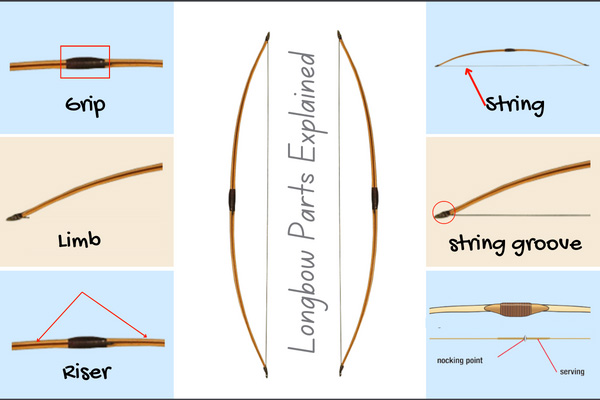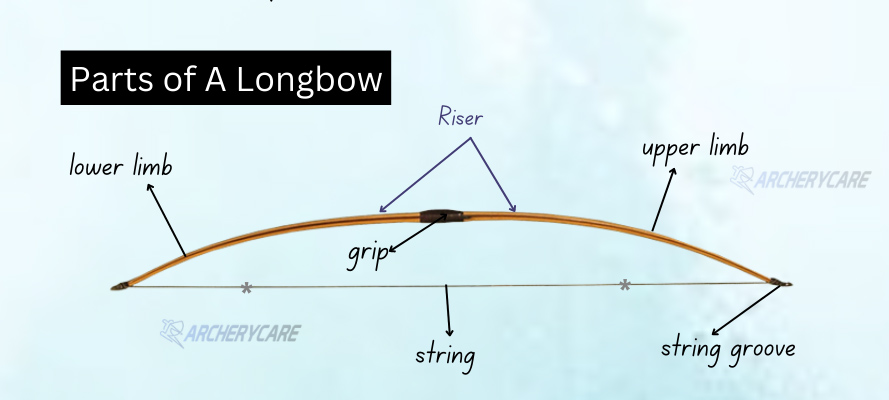Longbows are as artistic as they get. One would have to admire every inch of the bows made these days. Now, a beginner must figure out what are the parts of a longbow so that he isn't an amateur for long and pick up the right one.
And it would be a pleasure to describe each of these parts, as they truly make a beautiful hunting tool combined.
Once you are done with this article, you will feel more drawn to the amazing design of a longbow. Thus, familiarity will develop between you and your dashing possession, making you a more confident archer and hunter with time.
Longbow Parts Explained
A longbow is made of a few core parts mainly. And there are a few additional minor parts that add to the design's brilliance and sturdiness.

Grip
We are talking about one of the most crucial parts of the longbow. You don't need us to tell you that the grip needs to be perfectly suitable for your hands. Yes, you will never be comfy with a longbow grip that feels alien. And the material used for the grip will be the same as the material of the riser.
Though there are various designs to choose from, we would suggest that yours contain a curved grip. This way, you will find the bow more forgiving.
Limb Bolts
Then comes the limb bolts. These round-shaped bolts do the job of connecting the limbs with the riser. There's not much about them, apart from the fact that you cannot operate with loose bolts. And be careful! Loose bolts can cause serious problems. So, before you set out for hunting, always ensure their tightness.
Riser
This is the center part of a longbow. The riser connects the limbs. Not only that, it contains the shelf – meaning the shooting part. You will also find the grip in it. The riser is usually made of wood . And how stunning the wood makes it look!
Now, if you aren't cool with wood, then you can always choose composite or any other material.
Let's also talk about the design of the riser. It's curvy most of the time. And it's a bit thicker than the limbs. See, the thickness plays an important role in providing you with a solid grip.
However, make sure that the riser isn't too heavy. Ease of use is always the priority while shooting the arrows. And a properly lightweight riser is just what you need for convenience shooting.
Shelf
You will place the arrow on the shelf while shooting. Therefore, it needs to be the smoothest among all the parts. Usually, the shelf contains a sight window to allow you proper visualization. If you cannot shoot without this feature, then make sure that the longbow does have a sight window or two.
The shelf is customizable at times. So, even if you aren't comfortable with the built-in shelf of your longbow, don't be shy about customizing one. You can always put an arrow rest on the shelf for more shooting accuracy.
Limbs
Now we are talking about the most significant parts. Limbs contribute most to the weight and length of your weapon. Therefore, whenever you are assessing the bow length, you are measuring the length of the limbs. And we would prefer smaller limbs if we were to consider lightweight bows.
You will find two limbs in the longbow. The distance between the top limb and the string is known as the tiller. They measure the fraction of the upper limb versus the lower through this.
String
Long bow string is the sensitive part. We are saying this because you will hear many times that the strings wear out. No need to be apprehensive, though. With sturdy material in place, all you got to do is ensure proper maintenance.
Besides, you will find a 6-8 inches long extra string wrapping the center of the string. It goes by the name 'serving.' It's there to protect the limb string from wearing out too quickly. The limb string comes with various forms of twisting. And each one of them is made to suit the different shooting styles.
Other Parts
From one end of the limb string to the other, you will find two string grooves and two string tips. And between the grip and the string, the area is called the brace height. This terminology is often used in the overall measurement of the longbow by the bowyers.
When you hear that the bow is at brace, it means that the bow is at rest. Now, there's the face of the bow and the back. The part of the bow that is facing you is the face of the bow. And the part that is facing away from you is the back.
Final Words
There goes the anatomy of a longbow. If you are still confused about the parts of a longbow, you can shoot the questions clouding your mind. We will be responsive.
They say that a person has a way of communicating with his weapon. So, with time, you will become more familiar with every tiny detail of your longbow.
Related Guides You Might read:

